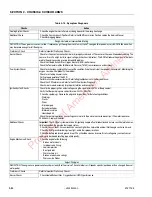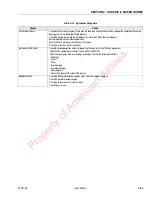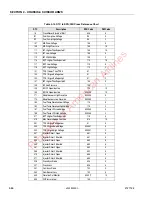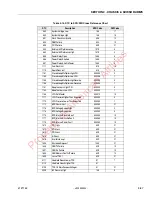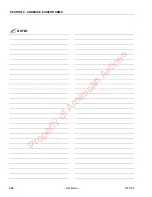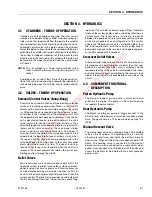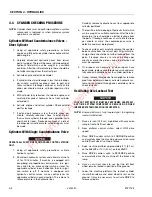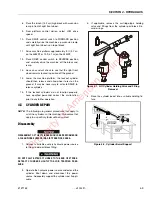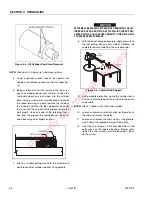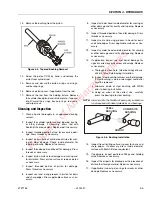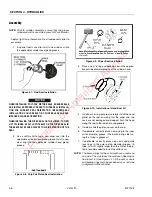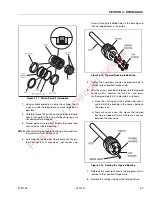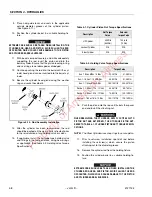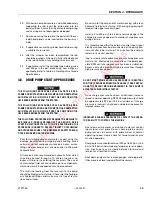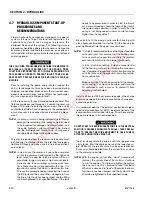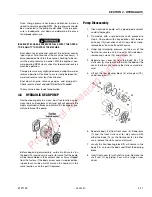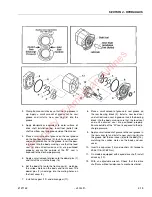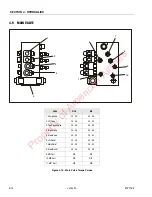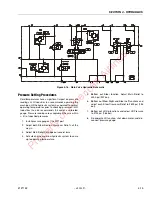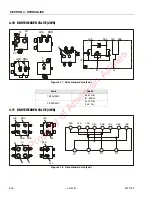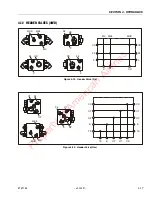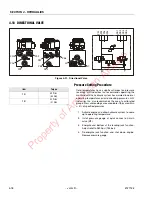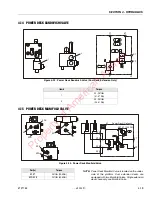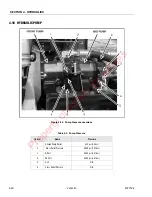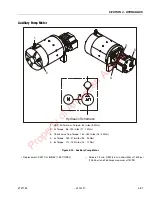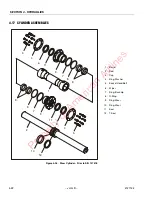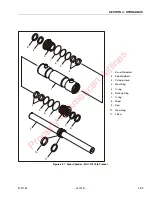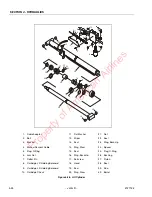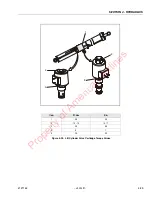
SECTION 4 - HYDRAULICS
4-10
– JLG Lift –
3121133
4.7
HYDRAULIC COMPONENT START-UP
PROCEDURES AND
RECOMMENDATIONS
From a hydrostatic component standpoint, the goal at
system start up is to put into functional operation, the
hydrostatic system in such a way as to preserve the
designed life span of the system. The following start-up
procedure should be adhered to whenever a new pump
or motor is initially installed into a machine, or a system is
restarted after either a pump or motor has been removed
and/or replaced.
THE FOLLOWING PROCEDURE MAY REQUIRE THE MACHINE TO
BE DISABLED (WHEELS RAISED OFF THE GROUND, WORK
FUNCTIONS DISCONNECTED, ETC.) WHILE PERFORMING THE
PROCEDURE IN ORDER TO PREVENT INJURY. TAKE NECES-
SARY SAFETY PRECAUTIONS BEFORE MOVING THE VEHICLE/
MACHINE.
Prior to installing the pump and/or motor, inspect the
unit(s) for damage that may have been incurred during
shipping and handling. Make certain that all system com-
ponents (reservoir, hoses, valves, fittings, heat exchanger,
etc.) are clean prior to filling with fluid.
Fill the reservoir with recommended hydraulic fluid. This
fluid should be passed through a 10 micron (nominal, no
bypass) filter prior to entering the reservoir. The use of
contaminated fluid will cause damage to the components,
which may result in unexpected vehicle/machine move-
ment.
NOTE:
If a pump or motor is being replaced due to internal
damage, the remaining units (pump or motors) need
to be inspected for damage and contamination, and
the entire hydraulic system will need to be flushed
and the fluid replaced. Failure to do so may cause
considerable damage to the entire system.
The inlet line leading from the reservoir to the pump must
be filled prior to start-up. Check the inlet line for property
tightened fittings and make sure it is free of restrictions
and air leaks.
NOTE:
In most cases, the reservoir is above the pump inlet
so that the pressure head created by the higher oil
level helps to keep the inlet pressures within an
acceptable range and prevent high vacuum levels.
However, due to hose routing or low reservoir loca-
tions, there may be air trapped within this line. It is
important to assure that the air is bled from this line.
This can be accomplished by loosening the hose at
the fitting closest the pump. When oil begins to flow,
the line is full, the air has been purged, and the fitting
can be retightened to its specified torque. If the tank
needs to be pressurized in order to start the flow of
oil, a vacuum reading should be taken at the inlet of
the pump during operation in order to verify that the
pump is not being asked to draw an inlet vacuum
higher than it is capable of.
Be certain to fill the pump and/or motor housing with
clean hydraulic fluid prior to start up. Fill the housing by
pouring filtered oil into the upper case drain port.
NOTE:
It is highly recommended to use the highest possible
case drain port, this ensures that the housing con-
tains as much oil as possible and offers the greatest
amount of lubrication to the internal components.
In initial start-up conditions, it may be convenient to
fill the housing, just prior to installing the case drain
line. Component, (especially motor), location may be
such that access to the case drain port after installa-
tion is not realistic.
Make certain that the oil being used to fill the compo-
nent housing is as clean as possible, and store the
fill container in such a way as to prevent it from
becoming contaminated.
Install a 60 bar (or 1000 psi) pressure gauge in the charge
pressure gauge port in order to monitor the charge pres-
sure during start-up.
It is recommended that the external control input signal,
(electrical connections for EDC), be disconnected at the
pump control until after initial start-up. This will ensure that
the pump remains in its neutral position.
DO NOT START THE ENGINE UNLESS PUMP IS IN THE NEUTRAL
POSITION (0 DEGREES SWASHPLATE ANGLE). TAKE PRECAU-
TIONS TO PREVENT MACHINE MOVEMENT IN CASE PUMP IS
ACTUATED DURING INITIAL START-UP.
"Jog" or slowly rotate the engine until charge pressure
starts to rise. Start the engine and run at the lowest possi-
ble RPM until charge pressure has been established.
Excess air should be bled from the system lines as close
to the motors as possible.
NOTE:
With the engine on low idle, "crack", (loosen-don't
remove), the system lines at the motor(s). Continue
to run the engine at low idle and tighten the system
lines as soon as oil is observed to leak from them.
When oil is observed to "leak" at the motor the line is
full, the air has been purged, and the system hoses
should be retightened to their specified torque.
Property of American Airlines

